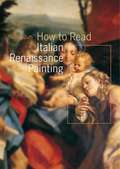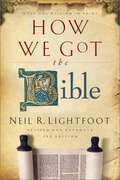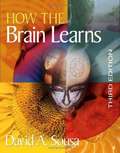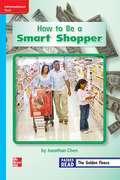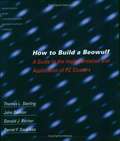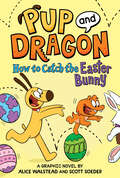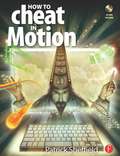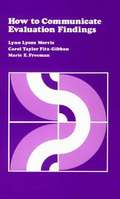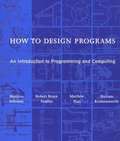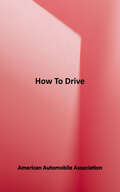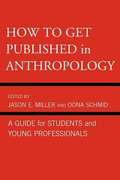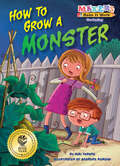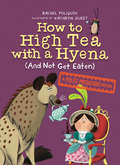- Table View
- List View
How To Read Italian Renaissance Painting
by Stefano ZuffiFilled with great masterpieces by such artists as Botticelli, Leonardo, Raphael, Michelangelo, Masaccio, Piero della Francesca, Mantegna, and Titian, How to Read Italian Renaissance Painting takes the reader into their world. As in the internationally successful and innovative How to Read a Painting, each spread uses an important painting as a way to explain a key concept, with numerous large details. Here, 180 works illuminate key ideas in Renaissance painting, from "perpective" and "the golden section" to "grace" and "symbolism." In addition, there are brief biographies of the major artists. The result is an original, accessible, and affordable volume that offers an introduction into the art and culture of the Italian Renaissance.
How We Got the Bible (Third Edition, Revised and Expanded)
by Neil R. LightfootHow and when did the books of the Bible originate? In what sense are these books different from other books? How have these books been preserved and transmitted to us? Why do we have so many different translations of the Bible? How We Got the Bible provides factual, accessible answers to questions like these. A classic guide for Bible students, it has sold more than 300,000 copies during its forty years in print. Now, in this new edition, each chapter has been revised and chapters have been added, including two on the Septuagint and the Latin Vulgate. This thorough revision will tempt fans of the previous edition and pave the way for a new generation of readers as well.
How a Seed Grows
by Holly Schroeder Denny BondThe fun and excitement of English and Language Arts learning continues in Grade 2 of Reading Street. This comprehensive and dynamic curriculum for homeschooling is geared toward young children who have some foundational English and Language Arts knowledge and are ready to strengthen their skills. Comprised of engaging activities, challenging content and weekly quizzes, Reading Street: Grade 2 is the next step in your child's path toward becoming a lifelong learner and reader. As with all Reading Street products, the Grade 2 system is formatted to help students meet certain age-appropriate goals. After completing this English and Language Arts homeschool program, your child should be able to: Read and comprehend two-syllable words. Identify common prefixes (such as pre-, un-, or re-) and suffixes (such as -able, -ad and -er). Correct mistakes made when reading out loud. Read books with two or more chapters. Understand the structure of stores (i. e. beginning, middle and end). Start selecting reading materials based on his/her own interests. Identify the "who," "what," "when," "where," "why" and "how" of the text. While the goals of second Grade English and Language Arts are numerous, Reading Street will help you craft engrossing lessons. Your child will garner important English and Language Arts skills while completing a workbook, reading stories and poems, and taking assessments. Planning these lessons will be easier than ever, as all Reading Street systems are broken down into weekly Big Ideas. All the work your child does on a given week is formulated around that single concept for an organized and challenging curriculum. With six easy-to-follow units, Reading Street: Grade 2 is the perfect tool for homeschooling parents. Your child will enjoy the reading selections and activities, and you'll love to see your student growing into a knowledgeable individual. We're confident that this product is the right one for you. For more information on the specific materials found in Grade 2 of Reading Street, check out the Features and Benefits page.
How the Brain Learns (3rd Edition)
by David A. SousaThe new, Third Edition of How the Brain Learns continues to focus on helping educators turn research on brain functioning into practical classroom strategies. This revised edition includes information on how the brain processes information and how this helps students learn, tips on maximizing student retention using "down time," and such familiar pedagogy from previous editions as the Practitioner's Corner, Key Points to Ponder, and pre- and post-assessments to measure the reader's knowledge. New to the third edition is: Updated information on the Information Processing Model to reflect newer terminology and understandings about memory systems Updated and exciting new research about language acquisition and how the brain learns to read An expanded chapter on thinking skills including the recently revised version of Bloom's Taxonomy More examples of how emotions influence learning and memory New Practitioner's Corners An updated resource section that includes additional books and Internet sites More primary sources for those who wish to review the actual research studies
How the Camel Got Its Hump
by Katherine Scraper Lori O'Dea Juan Bautista Juan OliverNIMAC-sourced textbook
How the Sparrow Learned Its Song (Inheritance and Traits)
by Ashley Chase Ari Krakowski Channon JacksonNIMAC-sourced textbook
How the Stars Got Into the Sky: Two Native American Pourquoi Tales (Text Connections Ser.)
by Joe HayesNIMAC-sourced textbook <P><P> Have you ever wondered how the stars got into the sky? Native American cultures came up with their own answers to that very question. The Navajo people believed clever Coyote was responsible, while the people of the Cochití Pueblo told about the adventure.
How to Be a Cat
by Nikki McClure“The simplicity and flow of page design are beautifully done as viewers follow a kitten and his mother as she teaches him basic feline behavior.” —School Library Journal (starred review)In cut-paper artist Nikki McClure’s latest picture book, a kitten practices the basics of feline behavior over the course of a day. A single word of text per spread teaches readers “how to be a cat”—how to stretch, clean, pounce, feast—while the striking paper cuts illustrate the kitten’s attempts to imitate an adult cat’s mastery of each skill. At times the kitten triumphantly succeeds, and at other times the kitten struggles, in vignettes that range from whimsical to profound.A celebration of all things feline, How to Be a Cat also tells a universal story of mastering life skills, and of the sometimes tender, sometimes stern relationship between parent and child, teacher and pupil. Cat lovers of all ages will connect to this loving portrayal of a mentor-student relationship.“Purrrrfect for beginning readers and little artists with an eye for fine cut-paper compositions and craftsmanship.” —Kirkus Reviews (starred review)“The lively verbs and pictures will inspire young readers to imitate the kitten’s actions, all the way to the last page, when the two cats curl up to ‘Dream.’ Part concept book of actions, part a day in the life of a cat, the pages provide two kinds of narratives, no small feat for such a simple-looking story.” —New York Journal of Books“McClure’s cut-paper spreads can be mesmerizing.” —Publishers Weekly“McClure wonderfully captures the shape and movement of the feline form.” —The Bulletin of the Center for Children’s Books
How to Be a Cloud Spotter (Fountas & Pinnell Classroom)
by Jane GerverHeads Up! We're used to seeing clouds in the sky: high clouds, low clouds, thin or fluffy clouds, dark or white clouds. But there's much more to know about clouds and the part they play in our lives. NIMAC-sourced textbook
How to Build a Beowulf: A Guide to the Implementation and Application of PC Clusters
by Thomas L. Sterling John Salmon Donald J. Becker Daniel F. SavareseSupercomputing research--the goal of which is to make computers that are ever faster and more powerful--has been at the cutting edge of computer technology since the early 1960s. Until recently, research cost in the millions of dollars, and many of the companies that originally made supercomputers are now out of business. The early supercomputers used distributed computing and parallel processing to link processors together in a single machine, often called a mainframe. Exploiting the same technology, researchers are now using off-the-shelf PCs to produce computers with supercomputer performance. It is now possible to make a supercomputer for less than $40,000. Given this new affordability, a number of universities and research laboratories are experimenting with installing such Beowulf-type systems in their facilities. This how-to guide provides step-by-step instructions for building a Beowulf-type computer, including the physical elements that make up a clustered PC computing system, the software required (most of which is freely available), and insights on how to organize the code to exploit parallelism. The book also includes a list of potential pitfalls.
How to Catch Graphic Novels: How to Catch the Easter Bunny (How to Catch Graphic Novels)
by Alice WalsteadFrom the creators of the New York Times and USA Today bestselling How to Catch series comes a new exhilarating graphic novel adventure!Pup has boundless energy and endless optimism; Dragon is cool and thoughtful but always up for adventure...together, they are best friends who are always there for one another. In their bounciest adventure, Pup and Dragon are trying to catch the Easter Bunny!Bursting with colorful art and hilarious text, Pup and Dragon: How to Catch the Easter Bunny is sure to appeal to How to Catch lovers and new young readers alike.More Pup and Dragon Adventures:Pup and Dragon: How to Catch an ElfPup and Dragon: How to Catch a DinosaurPup and Dragon: How to Catch a Unicorn
How to Cheat in Motion
by Patrick SheffieldThe text provides a "cookbook" style of learning computer animation, presenting the user with specific recipes to achieve desirable outcomes. This practical guide helps readers to enhance titles, motion graphics and visual effects with Motion. Step-by-step instruction is concisely described and lavishly illustrated.
How to Communicate Evaluation Findings
by Lynn Lyons Morris Carol Taylor Fitz-Gibbon Marie E. FreemanThe purpose of this book is to help you communicate the evaluation information you have collected. The book contains prescriptions and advice to help an evaluator provide information that will be usable and used at many stages of a program's development.
How to Design Programs: An Introduction to Programming and Computing
by Matthias Felleisen Robert Bruce Findler Shriram Krishnamurthi Matthew FlattThis introduction to programming places computer science in the core of a liberal arts education. Unlike other introductory books, it focuses on the program design process. This approach fosters a variety of skills--critical reading, analytical thinking, creative synthesis, and attention to detail--that are important for everyone, not just future computer programmers. The book exposes readers to two fundamentally new ideas. First, it presents program design guidelines that show the reader how to analyze a problem statement; how to formulate concise goals; how to make up examples; how to develop an outline of the solution, based on the analysis; how to finish the program; and how to test. Each step produces a well-defined intermediate product. Second, the book comes with a novel programming environment, the first one explicitly designed for beginners. The environment grows with the readers as they master the material in the book until it supports a full-fledged language for the whole spectrum of programming tasks. All the book's support materials are available for free on the Web. The Web site includes the environment, teacher guides, exercises for all levels, solutions, and additional projects.
How to Draw Animals (Fountas & Pinnell Classroom, Guided Reading Kindergarten)
by Denise ProwellNIMAC-sourced textbook
How to Drive: Making Driver Education Fun and Easy!
by American Automobile AssociationHow To Drive AAA 15th Edition is the most up-to-date textbook with full-color illustrations and diagrams throughout – everything a new driver needs to know in one convenient book. Revised in 2020 by American Automobile Association.
How to Find a Prince (Fountas & Pinnell Classroom, Guided Reading Grade 3)
by Anne Phillips Rupert WykNIMAC-sourced textbook
How to Get Published in Anthropology: A Guide for Students and Young Professionals
by Jason E. Miller Oona SchmidThis guide gives graduate students and young professionals the crucial information and tools they need to tackle the all-important requirement to publish. Part I provides guidance on key efforts including organizing a conference panel, creating a poster, presenting a paper, getting an article published, etc. In Part II, scholars offer first-hand insight into publishing in their area. Part III covers author contracts, copyright issues, collaboration, and online publishing opportunities.
How to Grow Tomatoes
by Kristin Cashore Nicole WongThe fun and excitement of English and Language Arts learning continues in Grade 2 of Reading Street. This comprehensive and dynamic curriculum for homeschooling is geared toward young children who have some foundational English and Language Arts knowledge and are ready to strengthen their skills. Comprised of engaging activities, challenging content and weekly quizzes, Reading Street: Grade 2 is the next step in your child's path toward becoming a lifelong learner and reader. As with all Reading Street products, the Grade 2 system is formatted to help students meet certain age-appropriate goals. After completing this English and Language Arts homeschool program, your child should be able to: Read and comprehend two-syllable words. Identify common prefixes (such as pre-, un-, or re-) and suffixes (such as -able, -ad and -er). Correct mistakes made when reading out loud. Read books with two or more chapters. Understand the structure of stores (i. e. beginning, middle and end). Start selecting reading materials based on his/her own interests. Identify the "who," "what," "when," "where," "why" and "how" of the text. While the goals of second Grade English and Language Arts are numerous, Reading Street will help you craft engrossing lessons. Your child will garner important English and Language Arts skills while completing a workbook, reading stories and poems, and taking assessments. Planning these lessons will be easier than ever, as all Reading Street systems are broken down into weekly Big Ideas. All the work your child does on a given week is formulated around that single concept for an organized and challenging curriculum. With six easy-to-follow units, Reading Street: Grade 2 is the perfect tool for homeschooling parents. Your child will enjoy the reading selections and activities, and you'll love to see your student growing into a knowledgeable individual. We're confident that this product is the right one for you. For more information on the specific materials found in Grade 2 of Reading Street, check out the Features and Benefits page.
How to Grow a Monster (Makers Make It Work)
by Kiki ThorpeLast year, Gabe's mom grew way too many zucchinis. This year, Gabe and his sister have a secret plan to take control of the garden. They have to stop the zucchini madness! Tying into the popular Makers Movement, Makers Make It Work is a series of fun easy-to-read stories that focus on problem-solving and hands-on action. This charming story explores the Makers theme of Gardening and includes explanatory sidebars and a gardening-related activity for young makers to try themselves!
How to High Tea with a Hyena: A Polite Predators Book (Polite Predators #2)
by Rachel PoliquinThe second book in a hilarious illustrated non-fiction chapter book series starring a savvy and stylish cockroach who guides the reader through an encounter with a charming -- and dangerous -- predator. Is this hyena drooling for tea and crumpets . . . or for you?!Celeste is a cockroach, and everyone knows that cockroaches are survivors, so who better to give advice on surviving an encounter with a polite predator? High teas are dainty meals with pretty teacups: you nibble tiny cakes, sip milky tea and chit-chat about not-so-important things like why doughnuts have holes and if fish have eyebrows. But Ruby the hyena is loud, ferocious and tends to slober. High-speed gobbling makes good sense in the wild, but it is a definite no-no in the tearoom! And Ruby just happens to be Queen of a very large clan of hungry hyenas. Will high tea be ruined by uninvited guests? Is Ruby peckish for something other than Celeste's famous cream buns? Using her vast knowledge of hyenas, Celeste comes up with lots of strategies to get through high tea in one piece. Many of her suggestions are dangerous, most are absurd, but all are based on true hyena biology and hunting behavior.
